- Home
- Equipment Reviews
-
Amplification Digital Integrated Mono Block Preamplifier Phono Solid State Tube Analog Sources Cartridges Tape Tone Arms Turn Tables Digital Sources Digital Disc Players DACs Music Servers Streaming Music Services
-
Accessories Power Conditioners Room Accoustics Racks & Stands Audio Software Other iPod iPod Speakers iPod Headphones iPod Transports Headphones Over Ear On Ear In Ear Headphone Amplifier
-
- Audio News
- Event Reports
- California Audio Show, San Francisco
- Consumer Electronics Show
- T.H.E. Show
- Rocky Mountain Audio Fest
- AXPONA
- Salon Son & Image
- Hi-Fi Show & AV Expo
- High End
- Lone Star Audio Fest
- Capital Audio Fest
- TAVES - Toronto Audio Video Entertainment Show
- AK Fest
- Home Entertainment Show
- New York Audio $ AV Show
- Open House Events
- Spotlight
- Music
- The Columns
- 2024 California Audio Show
The Unissued Hi-Fi Album of Bob Mielke and The Bearcats, 1955
Recovering Artifacts of Mid-Side Stereo
This session was taped with a microphone arrangement called “mid-side.” The technique encodes both direct and ambient sound on two channels in a manner allowing subsequent discreet retrieval and rebalancing of direct and stereo microphone pickups.
The mid-side method utilizes two microphones with differing pickup patterns: a figure-8 (typically a large diaphragm condenser) “side” signal and a directional (cardioid) microphone, the “mid” signal. In this case, a Stephens and a Capps microphone were fed directly to an Ampex 350 tape deck.
For playback, a three-channel decoding matrix is set up. A duplicate of the figure-8 “side” channel is created, and inverted to negative polarity resulting in a matching stereo pair, which may be manipulated independently of the (“mid”) direct signal. Recovering mid-side stereo from these tapes required no equalization or dynamic manipulation to extract full range sound and a vivid stereo image.
Despite some remarkable technical advantages, mid-side stereo was never widely adopted by the recording industry and largely abandoned except for specialty applications. But in recent years it’s made a resurgence. Increasing numbers of professional and surround sound recorders, digital audio workstations and software are mid-side capable.
Notes on Personnel
Bob Mielke (trombone)
Bob Mielke (b. 1926) and associates were at the heart of an East Bay/Berkeley revival jazz contingent with a bold, fresh original sound from the mid-1950s onward. Mielke created his own jazz trombone style fusing elements from Kid Ory’s New Orleans tailgate tradition, the Harlem swing of J.C. Higginbotham and Duke Ellington’s “Tricky Sam” Nanton. His exemplar for playing New Orleans trombone parts was George Brunis on the 1939 Muggsy Spanier Ragtime Band records. Bob Mielke page: http://www.jazzhotbigstep.com/247312.html
Bunky Colman (clarinet)
Bunky Colman (1932-83) was the star of the Empirical session. His rich tones ring out from the first measures, displaying his finely nuanced tone and timbre. Colman’s delicate sound blooms in the lush acoustic space, highlighting his pleasing blend of New Orleans, Chicago and Swing jazz clarinet styles. The finely voiced horns supporting the clarinet in “Sing On” make it one of the band’s most exquisite charts.
This is the finest extant rendition of Colman’s original composition, “Blue Guaiac Blues,” the title drawn from his medical education. Guaiac is a test for cancer, and a blue guaiac reaction is cause for the blues. Tragically, Bunky himself died of cancer at age 50. Bunky Colman page: http://www.jazzhotbigstep.com/622734.html
P.T. Stanton (cornet)
P.T. Stanton (1923-87) rejected the horn’s clarion majesty in favor of a personal vocabulary of quavering growls, expressive cries and strangled tones. P.T. nearly always had a mute or hand in or near the bell of his instrument ‘stressing’ his notes. Or he blew toward the tin derby hat he kept mounted on a stand and seen in these photos.
Stanton was the keystone and effectively music director behind the scenes. He was final arbiter on harmony and voicing of the horns, leading indirectly by emphasis and cadence, or verbally on the fly.
Though P.T. didn’t “front” or drive the band like a conventional horn player in a New Orleans or Dixieland ensemble, he supplied creative drive and key elements, such as in “Ice Cream” where his characteristically expressive and abstract lead sets the tone. (Stanton is featured in six new and forthcoming CD/download titles from Frisco Jazz Archival Rarities.) P.T. Stanton page: http://www.jazzhotbigstep.com/400354.html
Dick Oxtot (banjo, vocal)
Oxtot (1918-2001) played banjo, cornet, string bass and tuba. Oxtot ran his own bands on both sides of San Francisco Bay (often interchangeable with The Bearcats) and was closely associated with these musicians for half a century. The on-stage images from Jenny Lind Hall may actually be the slightly earlier Superior Stompers Jazz Band led nominally by Oxtot on the cusp of transition to The Bearcats in mid-1954.
A charming and dynamic vocalist Dick sings “My Lovin’ Imogene,” one of his best original songs. His rock steady banjo rhythms and the fabulous string bass of Peter Allen were an unmatched timekeeping clockwork. In his memoir, Mielke offered rich praise for Oxtot: “he was the best rhythm banjo player I ever played with. Good rhythm players, especially on that instrument, banjo, are so rare that he was like a diamond.” Dick Oxtot page: http://www.jazzhotbigstep.com/486423.html
A Star-Crossed Masterpiece
Sadly, The Bearcats’ first record failed in a complex saga. A handful of approval copies were produced in both tape and vinyl (pressed on 10-inch red vinyl no less). But grievous editing errors halted publication. Communication broke down and the venture folded.
A few years later Davey Jones sold Empirical. He continued working as a recording engineer but eventually dropped out of sight along with the tapes, which Mielke never recovered. Decades later, Jones became acquainted with jazz collector Joe Spencer and gave him the tapes, which Joe has made available.
The Bearcats Album Jinx
Mielke’s recording jinx persisted. No Bearcats record album emerged during the dozen years of the band regardless of their broad following and artistic merit. Though, there was a 45-rpm single issued and music circulated among enthusiasts for years on audiocassettes. This restored recording will soon be available on CD or download in the Frisco Jazz Archival Rarities series from Grammercy Records.
Despite the heartbreak of the Empirical Records chapter, Davey Jones’ pioneering technical achievement is undeniable. Re-mastering these formerly lost treasures from the original mid-side reels allowed recovery of maximum presence and detail while retaining the glorious ambience of Jenny Lind Hall. Six decades ago, he vividly captured the sound of this innovative young band at its inception, leaving us a visionary masterpiece that can at last be savored as first intended.
Frisco Jazz Archival Rarities page http://www.jazzhotbigstep.com/560123.html
Based on discussions, correspondence and corroboration by Bob Mielke and Joe Spencer. Drummer Don Marchant is seen in these photos, but it’s his alternate Don Fay heard in the session
See also:
Bob Mielke’s Bearcats at the Lark’s Club in Berkeley – Sound and Images, Frisco Cricket, SFTJF, 2015.
Part One http://sftradjazz.org/wordpress/article/542/
Part Two http://sftradjazz.org/wordpress/article/part-two/
Bob Mielke: A Life in Jazz, Jim Goggin, Trafford, 2008.
Jazz Scrapbook: Dick Oxtot-Me & Other Stuff, Dick Oxtot and Jim Goggin, Creative Arts, 1999.
Find more about these and other classic jazz musicians at the JAZZ RHYTHM website: JAZZHOTBigstep.com http://www.jazzhotbigstep.com/104.html
- ← Previous page
- (Page 2 of 2)

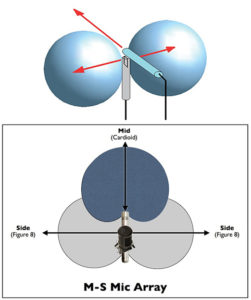
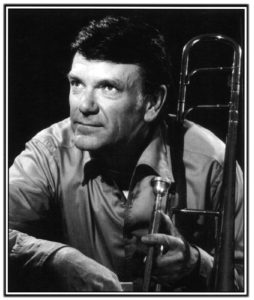
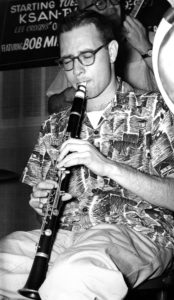
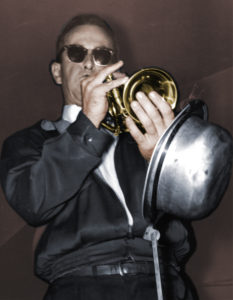
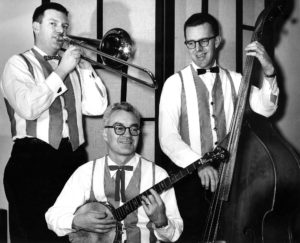
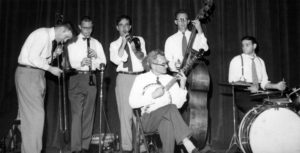
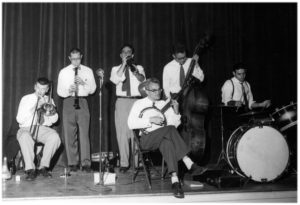
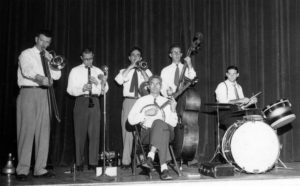
I have the Empirical tape recording of the Bearcats.